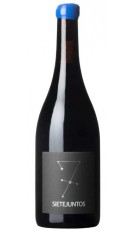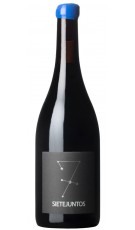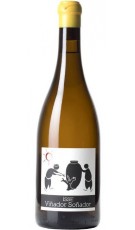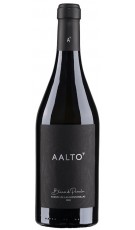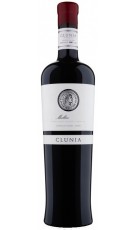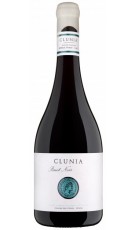
Vino de la Tierra de Castilla y León There are 138 products.
VT de Castilla y León
ORDEN AYG/296/2013, de 5 de abril, por la que se aprueba el Reglamento de la Indicación Geográfica Protegida «Vino de la Tierra de Castilla y León». Por O...
-
Finca El Rincón de Clunia
Red Wine.BODEGAS CLUNIAVino de la Tierra de Castilla y LeónThe grapes for this Tempranillo come from the "El Gerbal" estate, of 3.55 hectares located at an altitude of 950m. The vines of this vineyard benefit from the northwest wind that aerates and...
Reduced price! -
Clunia Tempranillo 2016
Red Wine.BODEGAS CLUNIAVino de la Tierra de Castilla y LeónThe grapes for this Tempranillo come from the "El Gerbal" estate, of 3.55 hectares located at an altitude of 950m. The vines of this vineyard benefit from the northwest wind that aerates and...
Reduced price! -
Clunia Albillo 2020
White Wine.BODEGAS CLUNIAVino de la Tierra de Castilla y LeónWhite wine made from vines of the native Albillo variety. From the Bocigas estate, located at an altitude of 1,000 metres. At this altitude, the extreme climate shapes the fresh aromas and balanced...
Reduced price! -
Ossian Magnum 2022
White WinePAGO DE CARRAOVEJASVino de la Tierra de Castilla y LeónWhite Wine Crianza, 10 months in oak barrels of 500 L with its lees
Reduced price! -
Cocktail from Fariña
Sweet White Wine.BODEGAS FARIÑAVino de la Tierra de Castilla y LeónCocktail, from Fariña, is a fresh, sweet and sparkling wine. It is especially suitable for a cocktail or aperitif, as an accompaniment to tapas or light dishes or not very sweet desserts.
Reduced price! -
MicroBio Sietejuntos Syrah...
Natural red wine.MICROBIO WINESVino de la Tierra de Castilla y LeónNatural red wine made from Syrah grapes, vertical press, 16-20 days of maceration, alcoholic fermentation with native yeasts in stainless steel tanks. Clay soils.
Reduced price! -
MicroBio Sietejuntos Merlot...
Natural red wine.MICROBIO WINESVino de la Tierra de Castilla y LeónNatural red wine made from Merlot grapes, vertical press, 16-20 days of maceration, alcoholic fermentation with native yeasts in stainless steel tanks. Clay soils.
Reduced price! -
MicroBio Issé "Tinaja" 2022
White Wine CrianzaMICROBIO WINESVino de la Tierra de Castilla y LeónWhite Wine Crianza.
Reduced price! -
Clunia Syrah 2019
Red Wine.BODEGAS CLUNIAVino de la Tierra de Castilla y LeónComing from the "La Encina" estate at an altitude of 975m, the vines are planted with a north-south orientation, so that leaves and fruit receive sunlight from morning to night. Surface of clayey...
Reduced price! -
Aalto Blanco de Parcela 2022
White Wine.AALTO Bodegas y ViñedosVino de la Tierra de Castilla y León100% Verdejo white wine from the Fuente de las Hontanillas plot located at 900 meters of altitude. It is aged in oak barrels that provide complexity and volume. A wine with a good evolution in the...
Reduced price!In stock -
Clunia Malbec 2020
Red Wine.BODEGAS CLUNIAVino de la Tierra de Castilla y LeónRed wine made from 100% Malbec. Vineyards with an altitude between 970 and 1,000 meters above sea level. It has a more extreme climate where winters are cold and warm, with a great thermal...
Reduced price!In stock -
Clunia Pinot Noir 2023
Red Wine.BODEGAS CLUNIAVino de la Tierra de Castilla y LeónRed wine made from 100% Pinot Noir. Variety that is characterized by its good adaptation to cold climates, which makes you feel at home in our vineyards in Coruña del Conde. Vineyards...
Reduced price!

VT de Castilla y León
ORDEN AYG/296/2013, de 5 de abril, por la que se aprueba el Reglamento de la Indicación Geográfica Protegida «Vino de la Tierra de Castilla y León». Por Orden de 15 de junio de 2000, de la Consejería de Agricultura y Ganadería («B.O.C. y L.» n.º 126, de 30 de junio), se reguló por primera vez el uso de la indicación geográfica «Vino de la Tierra de Castilla y León». Posteriormente, esta disposición sería derogada por la Orden de 10 de septiembre de 2002, de la Consejería de Agricultura y Ganadería («B.O.C. y L.» n.º 185, de 24 de septiembre), esta a su vez por la Orden AYG/323/2005, de 7 de marzo («B.O.C. y L.» n.º 51, de 15 de marzo) y, finalmente esta última, por la Orden AYG/57/2007, de 17 de enero («B.O.C. y L.» n.º 17, de 24 de enero), por la que se aprueba del Reglamento del «Vino de la Tierra de Castilla y León», actualmente en vigor. La Ley 24/2003, de 10 de julio, de la Viña y del Vino («B.O.E.» núm. 165, de 11 de julio), regula en su Título II el sistema de protección del origen y la calidad de los vinos, en concreto, en el artículo 19, los vinos con derecho a la mención tradicional «vino de la tierra».
Location
Castilla y León consists of a plateau with slight inclination East-West, surrounded by mountain systems: to the North, the Cantabrian mountains; to the Northeast, the Iberian; to the South, the Central and Northwest, the Montes de León.
Soils
Morphologically Castilla y León is a large basin filled by tertiary materials (conglomerates, clays, Sands and loams) Miocene. At certain points, they are protected by other materials more resistant to erosion, giving rise to the Moors, characteristic of the regional landscape. Moreover, there are rivers, which make up vegas and terraces and the outcrops of the socket Paleozoic in the western part of the Region. All of this ends up composing the morphological units of Castilla y León.
Climate
The predominant climate in Castilla y León is, therefore, continental semiarid Mediterranean-style, characterized by long, cold winters and short, warm and dry summers with a regime of scarce and unevenly distributed rainfall throughout the year, as well as for the extensive period of frost, with frequent late frosts and marked temperature fluctuations between summer and winter, and between day and night.
Vineyards
Growing conditions will be those that tend to get the best qualities of grape. They will be so they express the best balance between vegetation and the quality of the production.
Grapes
Whites: Albillo Mayor, Albillo Real, Viura (sin. Macabeo) y Verdejo. Authorized: Rojal (sin.: Malvasía Riojana, Alarije), Albarín Blanco, Albariño, Chardonnay, Malvasía Castellana (sin. Doña Blanca), Gewürztraminer, Godello, Montúa (sin. Chelva), Moscatel de Alejandría, Moscatel de grano menudo, Hondarrabi Zuri, Palomino, Riesling, Sauvignon Blanc, Treixadura y Viognier.
Reds: Garnacha Tinta, Juan García (sin. Mouraton), Mencía, Prieto Picudo y Tempranillo (sin.: Tinto Fino, Tinta del País, Tinta de Toro). Authorized: Bruñal (sin. Albarín Tinto), Cabernet Sauvignon, Garnacha Roja (sin. Garnacha Gris), Garnacha Tintorera, Graciano, Malbec, Merenzao, Merlot, Hondarrabi Beltza, Petit Verdot, Pinot Noir, Rufete y Syrah.
Production 2012
The maximum yields allowed for the production of the wines protected by the protected geographical indication «Came from the land of CASTILLA Y LEÓN» will be 16,000 kg of grapes per hectare of area, both for white varieties to red varieties, more than 120 hectolitres of wine per hectare may not be obtained.
Wines
The wines protected by the protected geographical indication «Came from the land of CASTILLA Y LEÓN» belong to category 1 "wine", 3 "liqueur wine" category, the category 5 "quality sparkling wine", category 8 "semi-sparkling wine" and 16 "wine of overripe grapes" category in accordance with annex XI ter of Regulation (EC) No 1234 / 2007.

(+34) 91 129 11 11
(+34) 638 458 218
- Brandy
- Cognac
- Gin Premium
- Ron
- Whisky
- Denomination of Origin
- Winery























